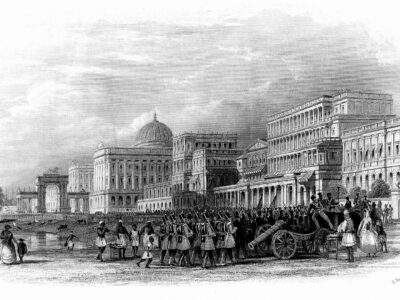India’s modern Government and politics have a distinct influence from the East India Company’s imperial rule, capitalism, and colonization. Throughout history, India has faced numerous invasions from foreigners. Before Europeans, India was a wealth hotspot, attracting raiders and becoming home to many immigrants and traders. None of the early European entrants, i.e., the Portuguese, the Dutch and the French, including the British, came to India to settle here but were fascinated by the fabulous wealth and goods that had a big market in Europe. In the 17th Century CE, the colonial rule by the British took intensive interest on a large scale to make India, for the first time, an economic supplement to a foreign monarch.
The British initially ventured into India as a trading entity, following the footsteps of fellow European nations. The establishment, which eventually evolved into the renowned East India Company, received its charter under royal patronage from Thomas Smythe and John Watts in London on December 31, 1600 CE. By the dawn of the 1690s, the British had already established several strategic footholds, and their commercial endeavours were thriving. In their relentless pursuit of expanding trade territories and securing increasingly advantageous agreements with Indian rulers, the company’s officials swiftly propagated a complex web of deceit and unethical practices across the subcontinent.
They effectively managed to sway ministers, courtiers, and officials of the Mughal Durbar to their side through bribery and various enticing incentives. The situation took a turn for the worse following the passing of Mughal Emperor Aurangazeb in 1707 CE. The Mughal Empire began experiencing fragmentation, and the central authority grew feeble. Provincial leaders asserted their autonomy, and fissures in the once-unified realm widened. Capitalizing on the internal disunity and disagreement among India’s princely rulers, the East India Company employed a sly strategy to further its shady objectives. By orchestrating rivalries among the princes and strategically deploying its military support to one or the other, the company steadily bolstered its power and influence throughout the Indian subcontinent.
Here is an overview of the historical events and power dynamics between 1757 CE and 1772 CE in Bengal and other parts of India:
- Victory at the Battle of Plassey: The East India Company’s military campaign in Bengal, aided by Clive’s cunning tactics, bribery, and deceit, reached its zenith with the decisive triumph at the Battle of Plassey in 1757 CE.
- The defeat of Nawab Siraj-ud-Daula: Nawab Siraj-ud-Daula’s forces suffered a catastrophic loss, primarily due to the treacherous actions of his commander-in-chief, Mir Jafar, who betrayed him.
- Installation of Mir Jafar as Nawab: Subsequently, the East India Company appointed Mir Jafar as the new Nawab, who, in return, granted the Company control over the Zamindari of 24 Parganas.
- Replacement of Mir Jafar with Mir Kasim: In 1760 CE, the company replaced Mir Jafar with Mir Kasim, rewarding him with control over three additional districts: Chittagong, Burdwan, and Midnapore.
- Emergence of Company as Dominant Power: With the newfound ability to change the Nawab at their discretion, the East India Company became the de facto sovereign authority in Bengal. This marked the beginning of the British Empire’s foothold in India, with the Battle of Plassey in 1757 CE as a significant turning point.
- Other Major Events Post the Battle of Plassey:
- In 1759 CE, Shah Alam ascended the throne of Delhi.
- In 1764 CE, the East India Company achieved a significant victory over the Nawabs of Awadh and Bengal and the Mughal Emperor Shah Alam, whom the Nawabs had employed as a symbolic figurehead during the Battle of Buxar.
- Following this victory, the Company gained control over all the powers of the Nawab of Bengal, rendering him a mere figurehead.
- The East India Company, through compulsion, secured the administrative rights from the Mughal Emperor Shah Alam for an annual payment of 26 lakh rupees. These rights encompassed revenue collection, administration supervision in Bengal, Bihar, and Orissa, and the jurisdiction to govern civil justice within these territories. Furthermore, the Company assumed authority over handling and dissolving military forces.
- This division of power and responsibility marked a significant change.
Double Government and Exploitation: The nation’s subjects experienced unfair treatment due to the dual governance system that persisted between 1765 and 1772 CE; corruption was high during this period.
With the arrival of Lord Warren Hastings as the new governor of Bengal, the dual governance ended in 1772 CE. The East India Company openly assumed control of Bengal, Bihar, and Orissa, facing financial difficulties and seeking loans from the British Government. Seizing the opportunity, the Government moved to bring the Company under Parliamentary regulation, introducing the Regulating Act of 1773, followed by various acts till 1853 CE. By this time, the East India Company had dominion over most of India. Princely states were either taken over or coerced into treaty alliances recognizing British supremacy. The conquest of Bengal was exceptional in Indian history, involving inexperienced merchants and clerics, not professional soldiers. Furthermore, it was funded entirely by the conquered population, and the conquerors relied heavily on Indian sepoys from diverse backgrounds.
The colonial rule subjugated or exploited the local population by the British, enforcing their laws and using the resources of the controlled Indian regions for their benefit. The British subjugation of India bore a distinct imprint, setting it apart from all preceding instances of domination over the land. Historically, shifts in governance signified nothing more than a transfer of power from one dynasty to another, merely altering the political reins without disturbing the intricate tapestry of society, the mechanisms of productivity, the structures of ownership, or the methods of governance. However, the advent of British dominion ushered in a transformative era, fundamentally reshaping these elements and initiating a socio-economic upheaval that ultimately dismantled age-old institutions and paved the way for the manifestation of novel social strata and dynamic forces.









